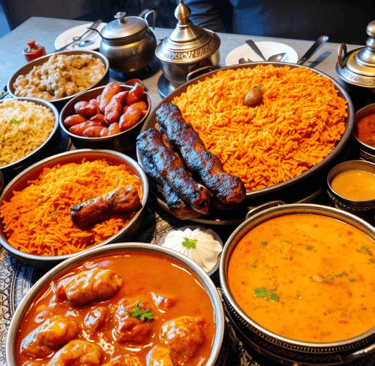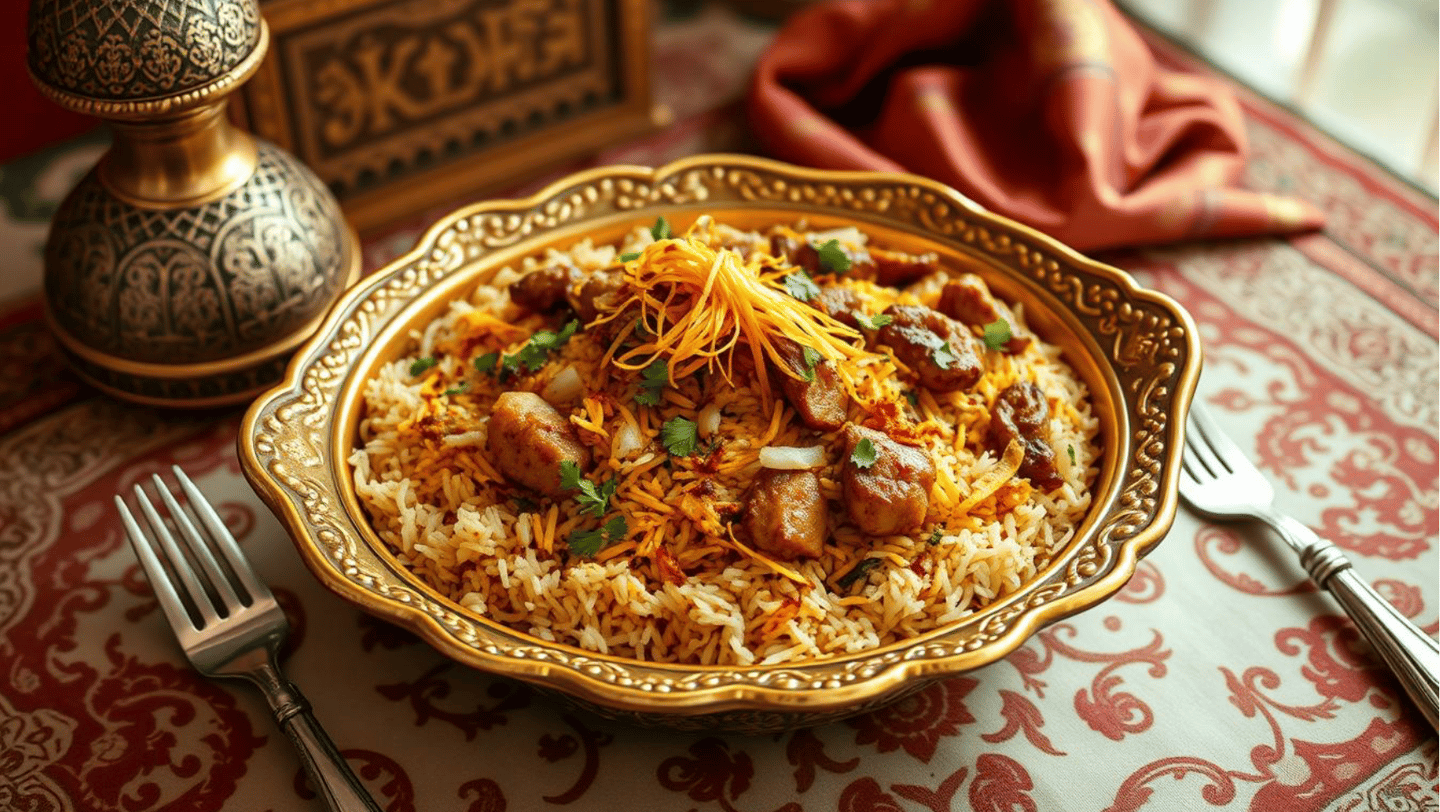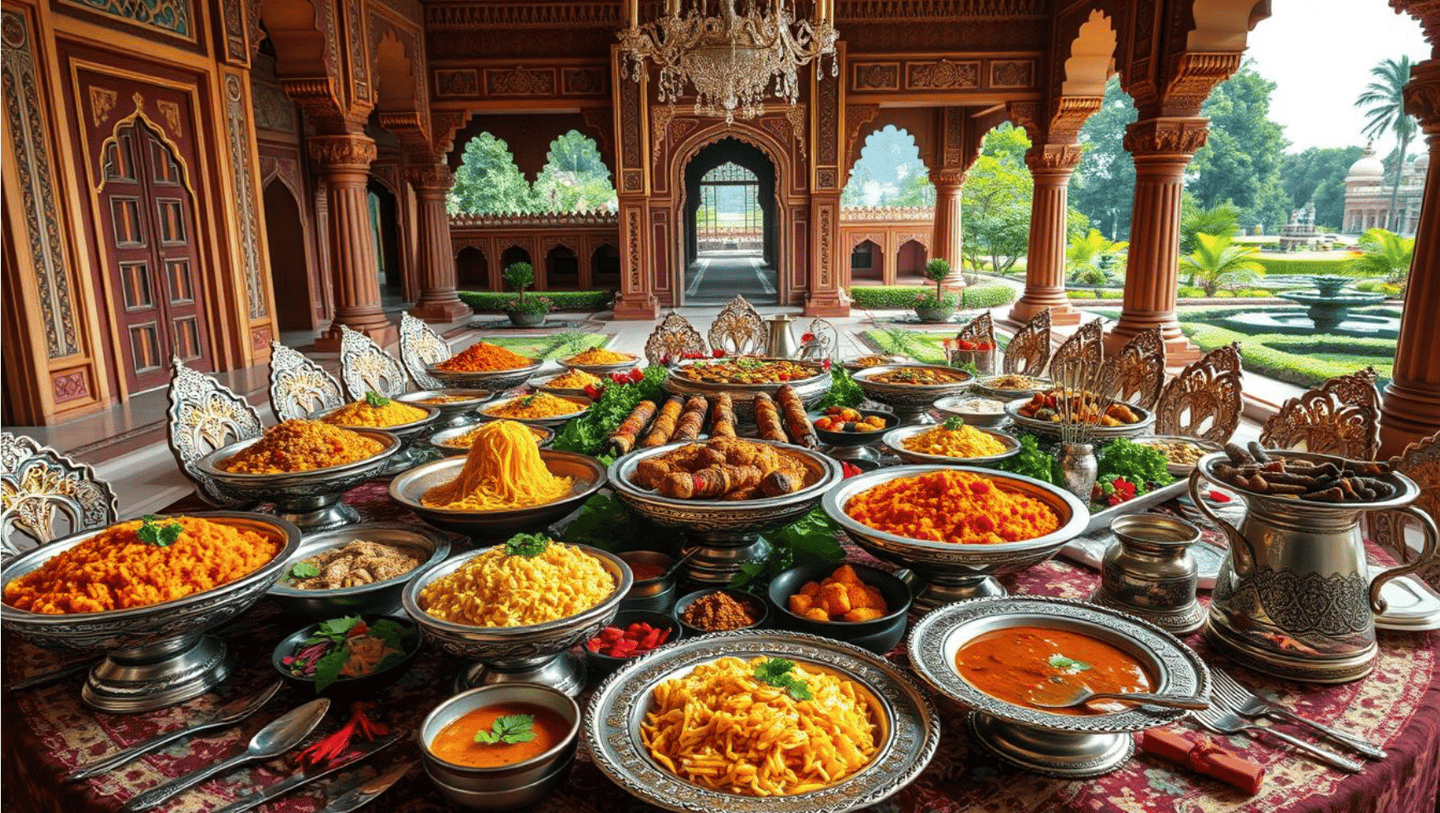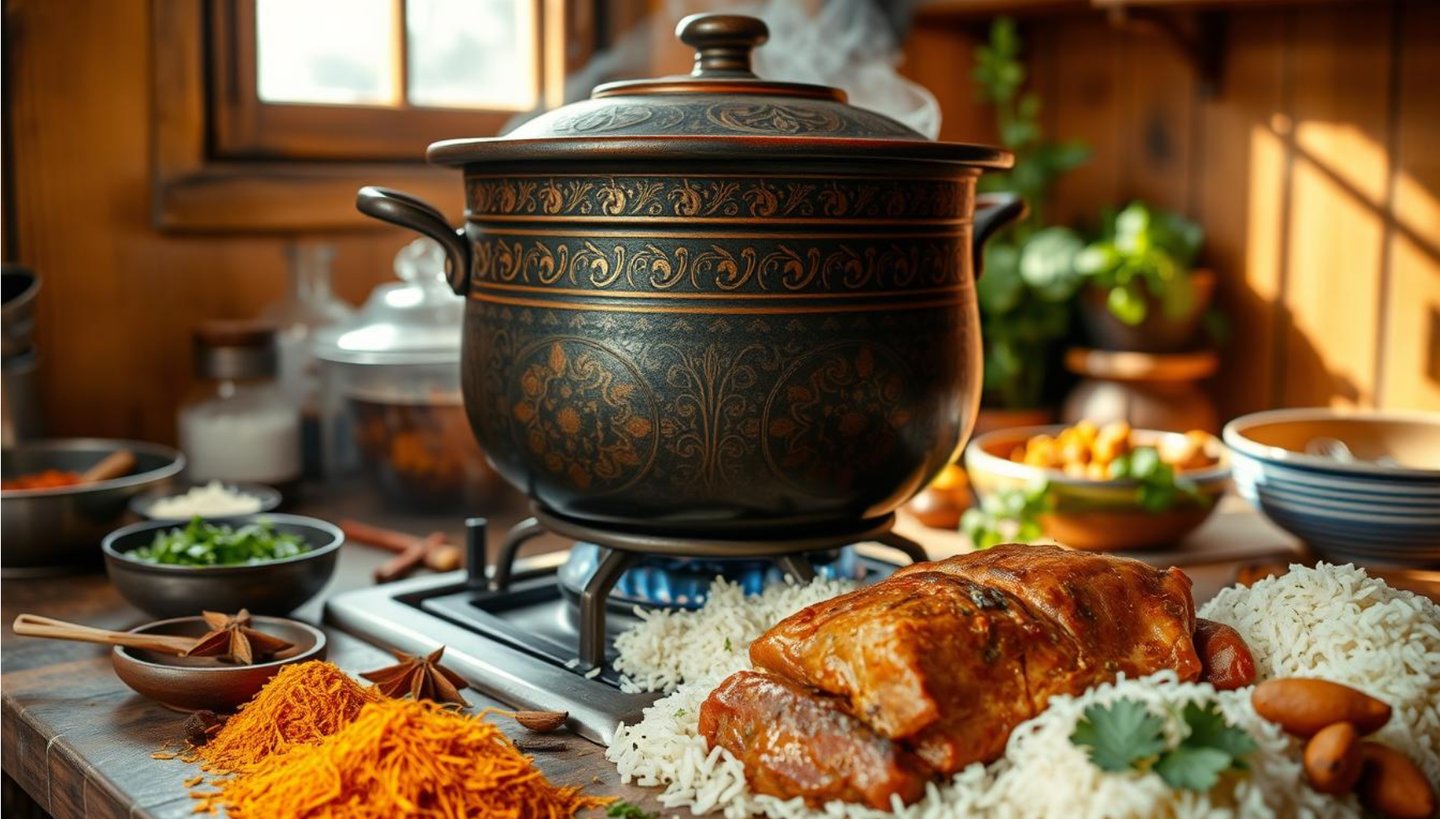Discover the Mughal Imprint on Indian Cuisine: Biryanis, Kebabs, and More
Explore the regal flavors of the Mughal emperors’ legacy on Indian cuisine, featuring exquisite biryanis, succulent kebabs, and opulent curries.
Anurag Shekhar
1/11/20256 min read


The Mughal emperors left a lasting mark on Indian food. Their influence began in the 15th century. They mixed Persian and Central Asian tastes with local ones.
This blend created beloved dishes like biryanis and kebabs. These dishes are still loved today.
Mughal food is known for its rich spices and detailed cooking methods. It has deeply influenced Indian food. Let's explore how the Mughals changed India's food scene.
The Origins of Mughal Cuisine
The Mughal cuisine has deep roots in the empire's culinary history. It started in Northern India, blending Persian and Central Asian flavors. The Mughal Empire was founded in 1526 by Babur, changing India's food scene.
Babur brought Uzbek cooking traditions. His successor, Humayun, added Persian touches. This mix created dishes like pilau, biryani, and kebabs, flavoured with saffron and cinnamon.
Akbar the Great added local Indian flavours to Mughal cooking. His kitchen combined Turkish, Afghani, and Persian methods with Indian tastes. This blend made dishes rich in mutton, fowl, and vegetables, but no pork or beef.
The Mughal Empire's influence spread to Delhi, Uttar Pradesh, Hyderabad, and Pakistan. Their cooking was known for slow-cooking and rich flavors, using ghee. Jehangir's reign brought more innovations, like colourful yogurt and healing spices.
Today, Mughal cuisine is enjoyed globally. Restaurants worldwide serve dishes like biryani, kebabs, and haleem. These dishes show the lasting impact of Mughal flavours.
Signature Mughal Dishes: Biryanis, Kebabs, and Rich Curries
Mughal cuisine emerged during the Mongol empire. It's known for its rich flavors, detailed techniques, and fancy presentation. The Royal Biryani is a prime example of this, showcasing the cuisine's luxury. It started in Mughal kitchens as a meal for armies.
This dish is layered with aromatic spices like saffron, cardamom, and cinnamon. These spices are key to its flavour.


Mughal cuisine also boasts a variety of kebabs. Seekh Kebabs and Galouti Kebabs are favorites, made with minced meat and spices. They were crafted in royal kitchens for their taste and texture.
Butter Chicken, or Murgh Makhani, is another highlight. It's loved for its creamy, buttery sauce. Kormas, with slow-cooked meats in a rich mix of nuts, saffron, and dried fruits, also showcase the cuisine's grandeur.
Mughal cuisine's curries and gravies are key, using nuts, dairy, and spices. Dum pukht, a slow-cooking method, makes dishes tender and flavorful. In Pakistan, Mughlai dishes are everywhere, showing the cuisine's lasting influence.
Traditional Indian dishes like Kormas, Kebabs, and Sheer Khurma add to Mughlai cuisine's reputation. These dishes reflect the royal grandeur and skill of Mughal cooking. They leave a lasting impression on the world of food.
Mughal Cooking Techniques
The Mughal Empire's cooking is known for its rich ingredients and advanced methods. Dum Pukht: The Art of Slow Cooking is a key technique. It seals food and cooks it slowly, keeping flavors and moisture in.
Another important method is Bhuna. It involves frying spices slowly to bring out their flavors. Then, these spices are mixed with the main ingredients.
Mughal dishes use these methods to create complex flavors. Dum Pukht: The Art of Slow Cookingmakes food rich and full of taste. Bhuna adds a spicy kick to dishes.
These techniques require patience and skill. Learning Dum Pukht and Bhuna takes time and effort. This study has shaped Mughal dishes loved worldwide.
Regional Variations of Mughal Dishes
Mughal cuisine is a mix of Indian, Central Asian, and Islamic flavors. It has made a lasting impact on many areas. Each place has its own twist, using local tastes and ingredients.
The Hyderabadi Biryani: Nizami Legacy comes from the Nizams' kitchens. It's famous for its perfect spice mix, fragrant basmati rice, and tender meat. Saffron and whole spices make it stand out, showing the luxury of Mughal meals.
Lucknowi Kebabs show the culinary skill of the Nawabs of Awadh. The Tunde ke kebab, for example, is made from minced buffalo meat. It's filled with spices and cooked slowly to be tender.
In South India, Mughal cooking has blended with local flavors. Biryani and kebabs have unique tastes from regional spices. Haleem, a slow-cooked stew, is also popular here.
The taste of regional Mughlai dishes comes from saffron, cardamom, and other spices. Cream, milk, and butter add to the flavor. These ingredients create a mix of tastes that people love worldwide.
Modern Interpretations of Mughlai Cuisine
Mughlai cuisine is known for its rich gravies and spices. It has moved into modern dining, blending old flavors with new techniques. Now, diners can try dishes that mix traditional Mughlai ingredients with global tastes.


Today, dishes like saffron Biryani and Seekh Kebabs are found in fancy restaurants. Chefs add almond and cashew pastes for creaminess. They also pair these dishes with new sides.
Milk and cream are key in making smooth gravies in Mughal recipes. The tandoor, a traditional cooking method, adds smoky flavor to kebabs. Ghee gives dishes a unique taste, making meals unforgettable.
Chefs are also mixing Mughlai flavours with other cuisines. For example, Mutton Rogan Josh might be served with creamy polenta. Or, Paneer Tikka could come with a quinoa salad. These dishes are popular worldwide, appealing to those who love history and modern flavours.
The Cultural Significance of Mughal Cuisine
Mughal cuisine is a big deal in Indian culture. It's more than just food; it's a tradition and a sign of hospitality. At weddings, religious events, and family get-togethers, dishes like biryani and kebabs bring everyone together.
The Mughal Empire, from the 16th to the 19th century, mixed Central Asian, Persian, and Indian cooking. This mix created a unique culinary heritage that still shapes Indian food today.
In Mughal feasts, spices like cardamom and cinnamon were key. Meat, like lamb and chicken, was cooked in tandoors. These feasts showed off the royal kitchens' grandeur with dishes like biryanis and kebabs.
Mughal cuisine has deeply influenced Indian hospitality. The fancy preparation and rich ingredients show respect for guests. Biryani and pulao are more than food; they're a warm welcome to Indian culture.
The Mughals introduced tandoori cooking and rich sauces. These traditions are still loved today. They make Mughal dishes a key part of Indian food and celebrations.
Recipes to Try at Home
Now, you can bring Mughal flavours into your kitchen. Try making Methi Biryani (Fenugreek Greens and Rice) and Eggplant Biryani. These dishes let you taste the rich history of Mughlai cuisine.
Mughal cuisine is a mix of Indian and Persian tastes. You can enjoy the unique flavors of Methi Biryanior the vegetarian delight of Eggplant Biryani. Here's how to make these dishes at home.


Methi Biryani (Fenugreek Greens and Rice):
Ingredients: Basmati rice, fenugreek greens (methi), onions, tomatoes, ginger-garlic paste, whole spices (bay leaves, cinnamon, cardamom), cumin seeds, garam masala, and fresh herbs like cilantro and mint.
Procedure: Start by washing and soaking the rice. Sauté the whole spices in oil, add onions, tomatoes, and ginger-garlic paste, then cook until golden. Add fenugreek greens and cook well. Layer the partially cooked rice over this mixture, add water, cover, and cook on low heat until rice is fully done.
Serving Suggestion: Garnish with fresh herbs and serve with raita or a side salad.
Eggplant Biryani:
Ingredients: Basmati rice, eggplants, onions, tomatoes, ginger-garlic paste, biryani masala, whole spices (bay leaves, cloves, cardamom), yogurt, and fresh herbs like mint and cilantro.
Procedure: Begin by soaking the rice. Slice and marinate the eggplants with salt and turmeric. Fry the onions until caramelized, then add tomatoes, ginger-garlic paste, and biryani masala. Fry marinated eggplants until tender. Layer the partially cooked rice with the eggplant mixture, add water, cover, and cook on low heat.
Serving Suggestion: Serve with a cooling yogurt dip and spiced pickle.
These recipes bring Mughal cuisine to life. Whether it's the herbal richness of Methi Biryani (Fenugreek Greens and Rice) or the flavourful layers of Eggplant Biryani, each bite is a taste of history and culinary art.
Conclusion
Exploring Mughal cuisine shows us a journey through history. It highlights its big impact on global and Indian food. We learn about its origins and techniques, like biryanis, kebabs, and rich curries.
Indian cuisine has a long history, over 5,000 years. It mixes flavours from different times and places. The ancient Indus Valley Civilization and the Vedic period added their touches. Later, the Maurya and Gupta empires brought more flavors.
When Islamic rule came in the 12th century, Mughal cuisine was born. It mixed Persian, Afghan, and Central Asian cooking styles. These styles have shaped Indian food forever.
Today, Mughal cuisine's influence is still strong. It blends with local and new cooking styles. Traditional dishes are loved everywhere, making festivals special and inspiring chefs.
Enjoying these dishes, we celebrate a culinary tradition that lasts. It enriches our taste and culture, connecting us across time.
